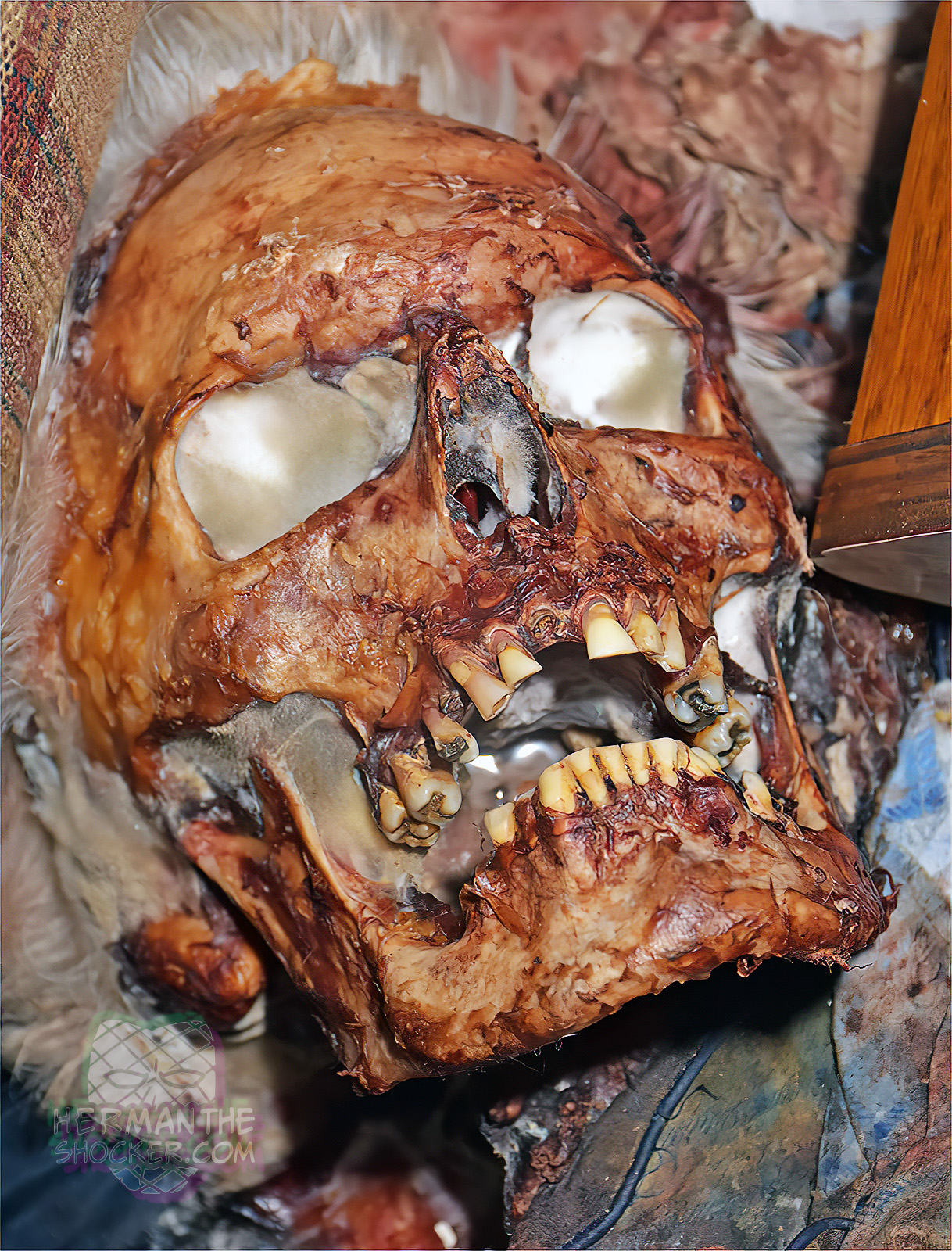Australia. A 69-year-old man was found lying on the floor at his home address(Fig. 1). According to the police report every room was filled with refuse and “thirty or so cats” were resident in the house. The body showed signs of extensive post mortem animal predation and a cat was actually present within the chest cavity. There was a past history of insulin-dependent diabetes mellitus and epilepsy.
At autopsy the body was that of a decomposing adult white male showing extensive desiccated post mortem injuries due to animal predation with complete loss of skin and soft tissues of the neck, anterior chest and upper abdomen. The lesions were dried with no evidence of vital reaction or hemorrhage. The chest had been stripped back to the underlying sternum and ribs on the left side. On the right side the entire anterior rib cage had been removed exposing an empty chest cavity with absent heart and lungs (Fig. 2).
The neck showed similar injuries with removal of the skin of the anterior neck and the right side, with loss of muscles and soft tissues through to the underlying cervical vertebrae. The esophagus, trachea, bronchi, larynx and thyroid gland were all absent and the transverse processes of the cervical vertebrae on the right side demonstrated animal bite marks. In the abdomen the intestines were exposed with skin and soft tissues stripped to the level of the umbilicus (Fig. 2). The liver had been almost completely eaten and there was damage to the right kidney and opening of the stomach, transverse colon and cecum.
The soft tissues and muscles of the face, forehead and anterior scalp had been completely stripped to the skull with loss of eyeballs and the right ear (the left ear was present and was mummified). The orbits were filled with an exuberant growth of white mold (Fig. 3).
The left arm had been stripped of skin and soft tissue down to bone below the elbow. The edges of the skin defect were ragged in keeping with animal bites rather than an incision from a sharp object (Fig. 4). A 35 × 45 mm fragment of pale skin was adherent to the back of the hand. The metacarpal bone of the little finger had been chewed through with detachment of the digit. The nails and distal portions of the phalanges were absent (Fig. 5). The right hand had also been stripped of skin and soft tissue to the bone from the mid-portion of the forearm. The fingertips and nails were absent. Preserved portions of pale skin were present on the palmar side of the fingers. The legs were intact with no evidence of predation and there were no injuries to the back.
The only medical conditions that could be identified were marked nodular hyperplasia of the prostate with trabeculation of the bladder and bilateral hydroureteronephrosis, and marked dorsal osteoarthritis.
The cause of death could not be determined from the autopsy given the absence of tissues and organs including the heart and lungs and the presence of early putrefaction. Both epilepsy and renal failure may have played a role in the terminal episode. There was no evidence of antemortem trauma. Toxicological evaluation revealed prescription medications only. The accuracy of the reported levels could not be verified given that they derived from residual chest fluid which had been contaminated by cats and the adjacent opened stomach.
Although it was asserted that the decedent owned as many as 30 cats this number was not able to be confirmed as the large number of cats at the scene soon escaped through the opened doors, including the one which was initially found within the empty chest cavity.
The irregular edges of the skin and soft tissue defects did not show abrasions from claw marks that are often found after canine feeding activity. Although cats usually tend to strip skin and soft tissues from the face and skull, the larger numbers of animals operating in this case had resulted in removal of the rib cage with opening of the chest and abdominal cavities exposing the heart, lungs and liver.
The case shows that considerable soft tissue, bone and organ loss may occur when a number of animals work in concert. The collective term for such a group of cats is a clowder. The extent of post-mortem damage from animal activity therefore relies not only on the species involved, but also the numbers of participating animals.
Feeding on human remains after death is usually the result of failure to find a body which is lying in a secluded or isolated environment in close proximity to foraging animals. This may occur both outdoors and inside dwellings, and on land or in salt or fresh water. The nature of the tissue damage is very much a reflection of the type of animal involved and the location, and may range from minor injuries such as superficial earlobe skin loss activity, to loss of limbs, genitalia and internal organs from large dog (Canis lupus familiaris) feeding.
On occasion post mortem injuries caused by a variety of animals may be mistaken for inflicted antemortem trauma and thus raise the possibility of homicide. Rarely animal predation may be intentional in cases where attempts are made to disguise a homicide, or as part of a religious ritual such as the sky burials in Tibet where bodies are deliberately left out in the open for Himalayan vultures.
The pattern of injuries is species dependent and can often be used to identify the likely animal responsible for feeding. For example, rodents tend to leave small paired gnaw marks on the fingers and toes in contrast to dogs which may remove soft tissue and bone. Bears and sharks tend to remove larger portions of the body, although it may on occasion be difficult to tell whether an attack occurred before or after death.
Diogenes or Havisham syndrome has a well-known association with post mortem animal predation. It is a syndrome most often found in the elderly that is characterized by social isolation, hoarding, marked lack of domestic hygiene and often a large number of pets. If death occurs the animals within the house, which usually include both domestic pets and a sizable rodent population, turn to the body for sustenance. In the current case the large number of cats living in the house had clearly controlled the rodent population resulting in no evidence of rodent predation on the body at autopsy.
In conclusion, the characteristics of the predation in this case were in keeping with cat activity. While larger dogs may devour more robust bones such as the skull and spine due to the size of their jaws and stronger biting power this case demonstrates that extensive tissue and organ loss may also occur when a number of animals work in concert, a “pack phenomenon”. Thus, the extent of post-mortem tissue and organ loss from animal activity in cases of post-mortem predation may be a function not only of the species of animal present, but also of the numbers of animals at the scene.
Latest posts













